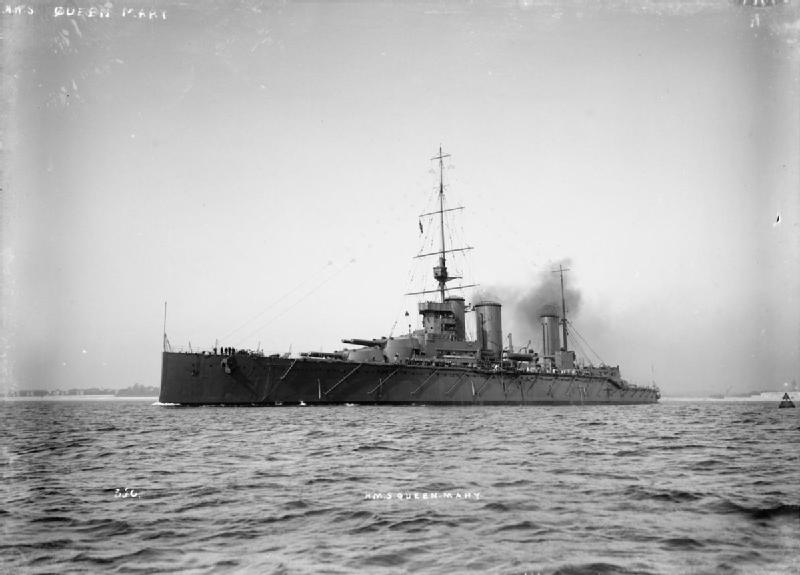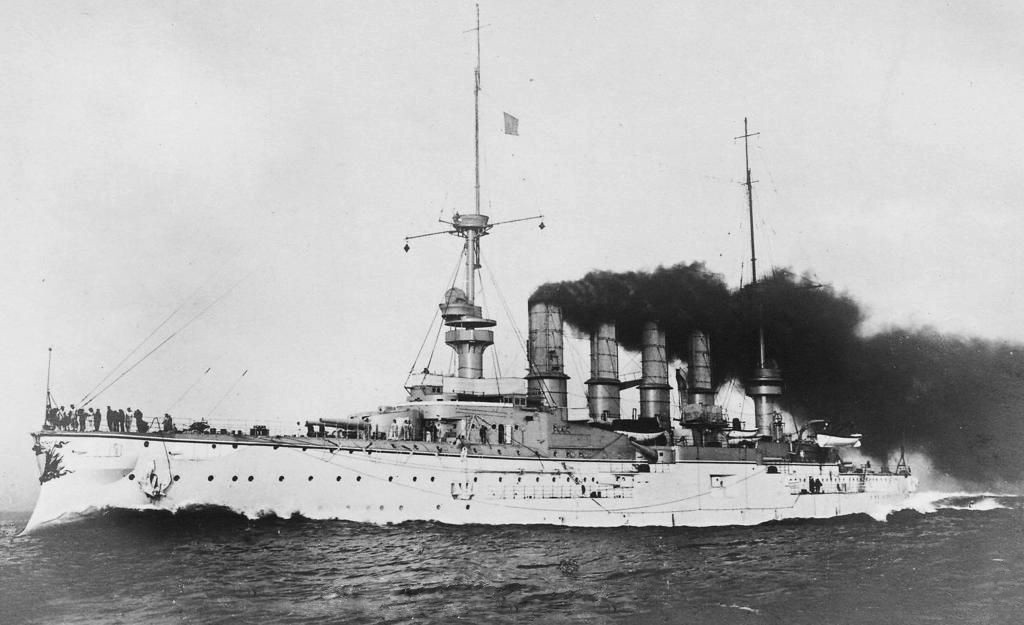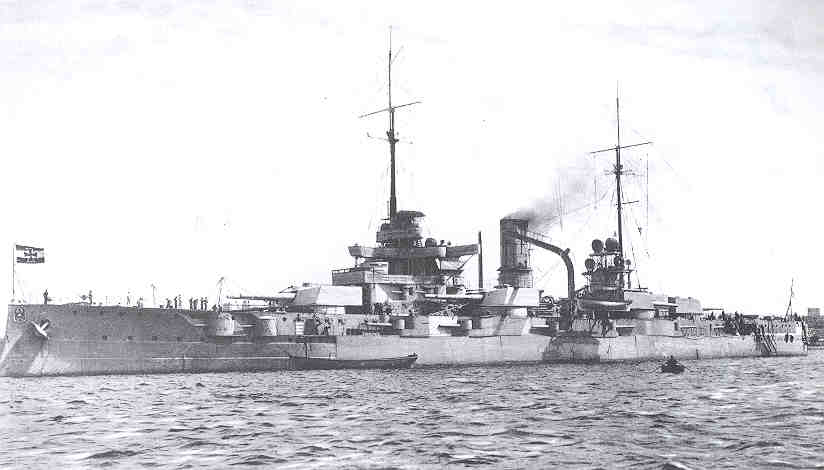|
Battlecruiser
The battlecruiser (also written as battle cruiser or battle-cruiser) was a type of capital ship of the first half of the 20th century. These were similar in displacement, armament and cost to battleships, but differed in form and balance of attributes. Battlecruisers typically had thinner armour (to a varying degree) and a somewhat lighter main gun battery than contemporary battleships, installed on a longer hull with much higher engine power in order to attain greater speeds. The first battlecruisers were designed in the United Kingdom as a successor to the armoured cruiser, at the same time as that the dreadnought succeeded the pre-dreadnought battleship. The goal of the battlecruiser concept was to outrun any ship with similar armament, and chase down any ship with lesser armament; they were intended to hunt down slower, older armoured cruisers and destroy them with heavy gunfire while avoiding combat with the more powerful but slower battleships. However, as more and more ... [...More Info...] [...Related Items...] OR: [Wikipedia] [Google] [Baidu] |
Battle Of Jutland
The Battle of Jutland () was a naval battle between Britain's Royal Navy Grand Fleet, under Admiral John Jellicoe, 1st Earl Jellicoe, Sir John Jellicoe, and the Imperial German Navy's High Seas Fleet, under Vice-Admiral Reinhard Scheer, during the First World War. The battle unfolded in extensive manoeuvring and three main engagements from 31 May to 1 June 1916, off the North Sea coast of Denmark's Jutland Peninsula. It was the largest naval battle and only full-scale clash of battleships of the war, and the outcome ensured that the Royal Navy denied the German surface fleet access to the North Sea and the Atlantic for the remainder of the war. Germany avoided all fleet-to-fleet contact thereafter. Jutland was also the last major naval battle, in any war, fought primarily by battleships. Germany's High Seas Fleet intended to lure out, trap, and destroy a portion of the British Grand Fleet. The German naval force was insufficient to openly engage the British fleet. This was par ... [...More Info...] [...Related Items...] OR: [Wikipedia] [Google] [Baidu] |
Fast Battleship
A fast battleship was a battleship which in concept emphasised speed without undue compromise of either armor or armament. Most of the early World War I-era dreadnought battleships were typically built with low design speeds, so the term "fast battleship" is applied to a design which is considerably faster. The extra speed of a fast battleship was normally required to allow the vessel to carry out additional roles besides taking part in the line of battle, such as escorting aircraft carriers. A fast battleship was distinguished from a battlecruiser in that it would have been expected to be able to engage hostile battleships in sustained combat on at least equal terms. The requirement to deliver increased speed without compromising fighting ability or protection was the principal challenge of fast battleship design. While increasing length-to-beam ratio was the most direct method of attaining a higher speed, this meant a bigger ship that was considerably more costly and/or could e ... [...More Info...] [...Related Items...] OR: [Wikipedia] [Google] [Baidu] |
HMS Hood (51) - March 17, 1924
HMS ''Hood'' (pennant number 51) was a battlecruiser of the Royal Navy (RN). ''Hood'' was the first of the planned four s to be built during the First World War. She was already under construction when the Battle of Jutland occurred in mid-1916, and that battle revealed serious flaws in her design; with drastic revisions, she was completed four years later. For this reason, she was the only ship of her class to be completed, as the British Admiralty, Admiralty decided it would be better to start with a clean design on succeeding battlecruisers, leading to the never-built G3 battlecruiser, G-3 class. Despite the appearance of newer and more modern ships, ''Hood'' remained the largest warship in the world for 20 years after her commissioning, and her prestige was reflected in her nickname, "The Mighty Hood". ''Hood'' was involved in many wikt:show the flag, showing-the-flag exercises between her Ship commissioning, commissioning in 1920 and the United Kingdom declaration of war o ... [...More Info...] [...Related Items...] OR: [Wikipedia] [Google] [Baidu] |
Dreadnought
The dreadnought was the predominant type of battleship in the early 20th century. The first of the kind, the Royal Navy's , had such an effect when launched in 1906 that similar battleships built after her were referred to as "dreadnoughts", and earlier battleships became known as pre-dreadnoughts. Her design had two revolutionary features: an "all-big-gun" armament scheme, with an unprecedented number of heavy-calibre guns, and steam turbine propulsion. As dreadnoughts became a crucial symbol of national power, the arrival of these new warships renewed the naval arms race between the United Kingdom and Germany. Dreadnought races sprang up around the world, including in South America, lasting up to the beginning of World War I. Successive designs increased rapidly in size and made use of improvements in armament, armour, and propulsion throughout the dreadnought era. Within five years, new battleships outclassed ''Dreadnought'' herself. These more powerful vessels were know ... [...More Info...] [...Related Items...] OR: [Wikipedia] [Google] [Baidu] |
Cruiser
A cruiser is a type of warship. Modern cruisers are generally the largest ships in a fleet after aircraft carriers and amphibious assault ships, and can usually perform several operational roles from search-and-destroy to ocean escort to sea denial. The term "cruiser", which has been in use for several hundred years, has changed its meaning over time. During the Age of Sail, the term ''cruising'' referred to certain kinds of missions—independent scouting, commerce protection, or raiding—usually fulfilled by frigates or sloop-of-war, sloops-of-war, which functioned as the ''cruising warships'' of a fleet. In the middle of the 19th century, ''cruiser'' came to be a classification of the ships intended for cruising distant waters, for commerce raiding, and for scouting for the battle fleet. Cruisers came in a wide variety of sizes, from the medium-sized protected cruiser to large armored cruisers that were nearly as big (although not as powerful or as well-armored) as a pre- ... [...More Info...] [...Related Items...] OR: [Wikipedia] [Google] [Baidu] |
Armoured Cruiser
The armored cruiser was a type of warship of the late 19th and early 20th centuries. It was designed like other types of cruisers to operate as a long-range, independent warship, capable of defeating any ship apart from a pre-dreadnought battleship and fast enough to outrun any battleship it encountered. For many decades, naval technology had not advanced far enough for designers to produce a cruiser that combined an armored belt with the long-range and high speed required to fulfill its mission. For this reason, beginning in the 1880s and 1890s, many navies preferred to build protected cruisers, which only relied on a lightly armored deck (ship), deck to protect the vital parts of the ship. However, by the late 1880s, the development of modern rapid-fire breech-loading cannons and high-explosive shells made the reintroduction of side armor a necessity. The invention of Case-hardening, case-hardened armor in the mid-1890s offered effective protection with less weight than previou ... [...More Info...] [...Related Items...] OR: [Wikipedia] [Google] [Baidu] |
Battle Of The Falkland Islands
The Battle of the Falkland Islands was a First World War naval action between the British Royal Navy and Imperial German Navy on 8 December 1914 in the South Atlantic. The British, after their defeat at the Battle of Coronel on 1 November, sent a large force to track down and destroy the German cruiser squadron. The battle is commemorated every year on 8 December in the Falkland Islands as a public holiday. Admiral Graf Maximilian von Spee commanding the German squadron of two armoured cruisers, and , the light cruisers , and , and the colliers SS ''Baden'', SS ''Santa Isabel'', and SS ''Seydlitz''Battle of the Falkland Islands -names the three German auxiliary ships and states that ''Bristol'' and ''Macedonia'' sank the colliers ''Baden'' and ''Santa Isabel'', while 'the other collier', ''Seydlitz'', escaped.- ''www.wo ... [...More Info...] [...Related Items...] OR: [Wikipedia] [Google] [Baidu] |
Imperial German Navy
The Imperial German Navy or the ''Kaiserliche Marine'' (Imperial Navy) was the navy of the German Empire, which existed between 1871 and 1919. It grew out of the small Prussian Navy (from 1867 the North German Federal Navy), which was mainly for coast defence. Wilhelm II, Kaiser Wilhelm II greatly expanded the navy. The key leader was Admiral Alfred von Tirpitz, who greatly expanded the size and quality of the navy, while adopting the Command of the sea, sea power theories of American strategist Alfred Thayer Mahan. The result was a Anglo-German naval arms race, naval arms race with Britain, as the German navy grew to become one of the greatest maritime forces in the world, second only to the Royal Navy. The German surface navy proved ineffective during the First World War; its only major engagement, the Battle of Jutland, was a draw, but it kept the surface fleet largely in port for the rest of the war. The submarine fleet was greatly expanded and threatened the British supply s ... [...More Info...] [...Related Items...] OR: [Wikipedia] [Google] [Baidu] |
German Imperial Navy
The Imperial German Navy or the ''Kaiserliche Marine'' (Imperial Navy) was the navy of the German Empire, which existed between 1871 and 1919. It grew out of the small Prussian Navy (from 1867 the North German Federal Navy), which was mainly for coast defence. Kaiser Wilhelm II greatly expanded the navy. The key leader was Admiral Alfred von Tirpitz, who greatly expanded the size and quality of the navy, while adopting the sea power theories of American strategist Alfred Thayer Mahan. The result was a naval arms race with Britain, as the German navy grew to become one of the greatest maritime forces in the world, second only to the Royal Navy. The German surface navy proved ineffective during the First World War; its only major engagement, the Battle of Jutland, was a draw, but it kept the surface fleet largely in port for the rest of the war. The submarine fleet was greatly expanded and threatened the British supply system during the U-boat campaign. As part of the Armist ... [...More Info...] [...Related Items...] OR: [Wikipedia] [Google] [Baidu] |
Battleship
A battleship is a large, heavily naval armour, armored warship with a main battery consisting of large naval gun, guns, designed to serve as a capital ship. From their advent in the late 1880s, battleships were among the largest and most formidable weapon systems ever built, until they were surpassed by aircraft carriers beginning in the 1940s. The modern battleship traces its origin to the sailing ship of the line, which was developed into the steam ship of the line and soon thereafter the ironclad warship. After a period of extensive experimentation in the 1870s and 1880s, ironclad design was largely standardized by the British , which are usually referred to as the first "pre-dreadnought battleships". These ships carried an armament that usually included four large guns and several medium-caliber guns that were to be used against enemy battleships, and numerous small guns for self-defense. Naval powers around the world built dozens of pre-dreadnoughts in the 1890s and early ... [...More Info...] [...Related Items...] OR: [Wikipedia] [Google] [Baidu] |
Capital Ship
The capital ships of a navy are its most important warships; they are generally the larger ships when compared to other warships in their respective fleet. A capital ship is generally a leading or a primary ship in a naval fleet. Strategic implications There is usually no formal criterion for the classification, but it is a useful concept in naval strategy; for example, it permits comparisons between relative naval strengths in a theatre of operations without the need for considering specific details of tonnage or gun diameters. A notable example of this is the Alfred Thayer Mahan, Mahanian doctrine, which was applied in the Sinking of Prince of Wales and Repulse, planning of the defence of Singapore in World War II, where the Royal Navy had to decide the allocation of its battleships and battlecruisers between the Atlantic and Pacific theatres. The Mahanian doctrine was also applied by the Imperial Japanese Navy, leading to its Preventive war, preventive move to Attack on P ... [...More Info...] [...Related Items...] OR: [Wikipedia] [Google] [Baidu] |











